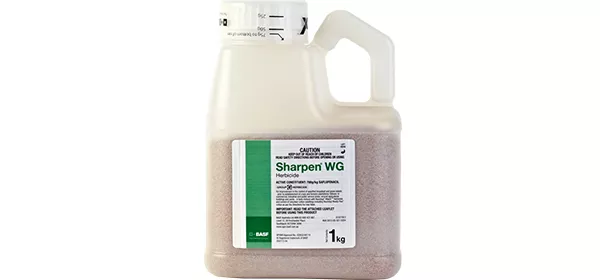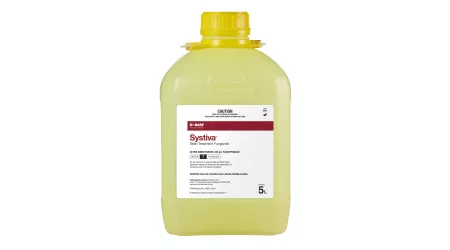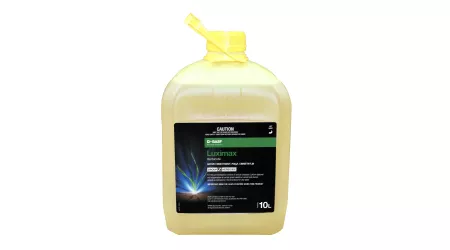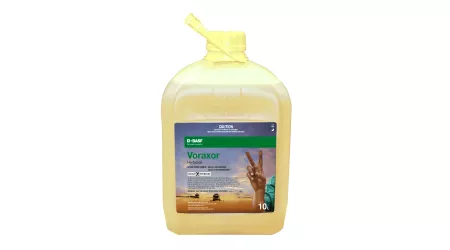Key benefits
- Targeted problem-solving from fallow to harvest
- Reduces the reliance on glyphosate
- Streamline harvesting with rapid desiccation of pulse crops
How it works
Sharpen® is a fast-acting contact herbicide and helps control weeds through a process of membrane disruption. The foliar uptake of Sharpen is rapid and plant desiccation can occur within 4 days of application. Application should target small, actively growing weeds. Subsequent germinations will not be controlled.
In most situations, Sharpen should be applied with a conventional boom sprayer with mechanical or bypass agitation in 80–250 L/ha water. Use higher water volumes if the weed infestation is dense or as weeds increase in size. Refer to label for further details.
More about Sharpen
-
Sharpen Knockdown
Fast broadleaf weed control prior to sowing certain grain crops and pastures, in fallow and in established lucerne crops.
Rate: 17–34 g/ha + 1% v/v high quality MSO. Refer to label for recommended use rates for targeted weeds. Most broadleaf weeds can be controlled at 17–26 g/ha, but more hard-to-control and older weeds should be treated at 26–34 g/ha.
Timing: Application should be made to small, actively growing weeds. Best control is achieved when weeds are exposed and are not shielded by other weeds and/or stubble. Problem broadleaf weeds that have germinated are easiest to control while in the small rosette growth stage. Refer to the label for ideal weed size targets.- Sharpen's unique systemic activity reduces regrowth.
- The only Group 14 (formerly Group G) herbicide that provides standalone control of 32 broadleaf weeds, reducing the dependency on glyphosate.
- Tank-mixes with either glyphosate or paraquat control an additional 14 grass and broadleaf weeds.
- Suitable for spraying in drift-sensitive areas such as near broadleaf crops (e.g. cotton) because of its low volatility.
- Mixing Sharpen with glyphosate or paraquat helps to achieve higher levels of weed control and ultimately helps reduce the weed seed bank.
-
Sharpen Weed Seed Set
Earlier and more effective seed-set reduction in cereals
Rate: 34 g/ha + 1% v/v Hasten or another high quality MSO.
Timing:Apply from GS71 to GS83 and at least 14 days before harvest.- Sharpen makes managing wild radish in the lead-up to harvest easier. Apply it early to protect cereal yields and set up next season. Using Sharpen to manage wild radish in the lead-up to harvest this season will help to reduce the weed burden in next year's crop.
- Optimal, uniquely early application window to minimise weed seed-set and protect crop yield
- Up to 90% reduction of viable wild radish seeds with negligible crop impact when applied from GS71
- Proven pay-off in the following season
Sharpen is the only herbicide that can be applied in wheat, barley and triticale from the watery ripe crop growth stage (GS71) to reduce wild radish seed-set.
Its high level of crop safety allows it to be applied in this very effective earlier application window prior to harvest than any of the other options for this use pattern. -
Sharpen as a Harvest Aid
Increase harvest efficiency and the value of the crop
Rate: 34 g/ha + glyphosate or paraquat at label rates + 1% Hasten or other high quality MSO
Timing: Apply once seeds reach full physiological maturity and at least 7 days before harvest.- Use Sharpen as a harvest aid in pulse crops to provide:
- Upgraded grain quality and storability through rapid, thorough desiccation
- Rapid burndown of key broadleaf weeds and reduction of green trash
- Improved harvest efficiency
-
Sharpen in Lucerne
Grow cleaner, more productive lucerne & pasture
Rate: 17-34 g/ha plus 1% Hasten or high quality MSO.
The registration of Sharpen Herbicide for broadleaf weed control in lucerne provides a much needed option for growers. It broadens BASF's product offer to lucerne producers with Spinnaker and Raptor herbicides already utilised for weed control across Australia.
Sharpen can only be used in established lucerne, at least 12 months old. For optimal coverage and control, apply after grazing or hay cut.
Sharpen can be used up to 1 hour before sowing sub clover based pastures for rapid and robust control. Tank-mixes with paraquat or glyphosate extend the control spectrum to 46 broadleaf and grass weeds.
Crop suitability
-
Almond
AmaranthAmsinckiaAnnual ryegrassAustralian crassulaBarley grassBindweed / climbing buckwheatBlackberry nightshadeBrome grassCaltropCapeweedCharlockCommon cat's earCow vine / Peach vineCrassula / stonecropFat henFleabaneHeliotropIndian hedge mustardKhaki weedKochiaMarshmallow / Small flowered mallowMedicsMuskweedPaterson's cursePenny cressPrickly lettuceScarlet pimpernelShepherd's purseSilver grassSlender thistleSnoutbeanSow thistle / Milk thistleSpiny emexStinging nettleStorksbillVolunteer canolaVolunteer cottonVolunteer pulse crops including lupin and chickpeaVolunteer wild oatsWild gooseberryWild radishWild turnip / turnip weedWireweed -
Barley
Amaranthus sppAmsinckiaAnnual ryegrassAustralian crassulaBarley grassBindweed / climbing buckwheatBlackberry nightshadeBladder ketmiaBrome grassCaltropCapeweedCharlockChickweedCommon cat's earCow vine / Peach vineCrassula / stonecropFat henFleabaneHeliotropKhaki weedKochiaMarshmallow / Small flowered mallowMedicsMuskweedPaterson's cursePenny cressPrickly lettuceScarlet PimpernelShepherd's purseSlender thistleSnoutbeanSow thistle / Milk thistleSpiny emexStinging nettleStorksbillTurnip weedVolunteer canolaVolunteer cottonVolunteer pulse crops including lupin and chickpeaVolunteer wild oatsWild gooseberryWild radishWild turnip / turnip weedWireweed -
Cereals
AmaranthAmsinckiaAnnual ryegrassAustralian crassulaBarley grassBindweed / climbing buckwheatBlackberry nightshadeBrome grassCaltropCapeweedCharlockCommon cat's earCow vine / Peach vineCrassula / stonecropFat henFleabaneHeliotropIndian hedge mustardKhaki weedKochiaMarshmallow / Small flowered mallowMedicsMuskweedPaterson's cursePenny cressPrickly lettuceScarlet pimpernelShepherd's purseSilver grassSlender thistleSnoutbeanSow thistle / Milk thistleSpiny emexStinging nettleStorksbillVolunteer canolaVolunteer cottonVolunteer pulse crops including lupin and chickpeaVolunteer wild oatsWild gooseberryWild radishWild turnip / turnip weedWireweed -
Citrus
AmaranthAmsinckiaAnnual ryegrassAustralian crassulaBarley grassBindweed / climbing buckwheatBlackberry nightshadeBrome grassCaltropCapeweedCharlockCommon cat's earCow vine / Peach vineCrassula / stonecropFat henFleabaneHeliotropIndian hedge mustardKhaki weedKochiaMarshmallow / Small flowered mallowMedicsMuskweedPaterson's cursePenny cressPrickly lettuceScarlet pimpernelShepherd's purseSilver grassSlender thistleSnoutbeanSow thistle / Milk thistleSpiny emexStinging nettleStorksbillVolunteer canolaVolunteer cottonVolunteer pulse crops including lupin and chickpeaVolunteer wild oatsWild gooseberryWild radishWild turnip / turnip weedWireweed -
Cotton
AmaranthAmsinckiaAnnual ryegrassAustralian crassulaBarley grassBindweed / climbing buckwheatBlackberry nightshadeBrome grassCaltropCapeweedCharlockCommon cat's earCow vine / Peach vineCrassula / stonecropFat henFleabaneHeliotropIndian hedge mustardKhaki weedKochiaMarshmallow / Small flowered mallowMedicsMuskweedPaterson's cursePenny cressPrickly lettuceScarlet pimpernelShepherd's purseSilver grassSlender thistleSnoutbeanSow thistle / Milk thistleSpiny emexStinging nettleStorksbillVolunteer canolaVolunteer cottonVolunteer pulse crops including lupin and chickpeaVolunteer wild oatsWild gooseberryWild radishWild turnip / turnip weedWireweed -
Oats
Amaranthus sppAmsinckiaAnnual ryegrassAustralian crassulaBarley grassBindweed / climbing buckwheatBlackberry nightshadeBladder ketmiaBrome grassCaltropCapeweedCharlockChickweedCommon cat's earCow vine / Peach vineCrassula / stonecropFat henFleabaneHeliotropIndian hedge mustardKhaki weedKochiaMarshmallow / Small flowered mallowMedicsMuskweedPaterson's cursePenny cressScarlet PimpernelShepherd's purseSlender thistleSnoutbeanSow thistle / Milk thistleSpiny emexStinging nettleStorksbillVolunteer canolaVolunteer cottonVolunteer pulse crops including lupin and chickpeaVolunteer wild oatsWild radishWild turnip / turnip weedWireweed -
Pasture
AmaranthAmsinckiaAnnual ryegrassAustralian crassulaBarley grassBindweed / climbing buckwheatBlackberry nightshadeBrome grassCaltropCapeweedCharlockCommon cat's earCow vine / Peach vineCrassula / stonecropFat henFleabaneHeliotropIndian hedge mustardKhaki weedKochiaMarshmallow / Small flowered mallowMedicsMuskweedPaterson's cursePenny cressPrickly lettuceScarlet pimpernelShepherd's purseSilver grassSlender thistleSnoutbeanSow thistle / Milk thistleSpiny emexStinging nettleStorksbillVolunteer canolaVolunteer cottonVolunteer pulse crops including lupin and chickpeaVolunteer wild oatsWild gooseberryWild radishWild turnip / turnip weedWireweed -
Pome fruit
AmaranthAmsinckiaAnnual ryegrassAustralian crassulaBarley grassBindweed / climbing buckwheatBlackberry nightshadeBrome grassCaltropCapeweedCharlockCommon cat's earCow vine / Peach vineCrassula / stonecropFat henFleabaneHeliotropIndian hedge mustardKhaki weedKochiaMarshmallow / Small flowered mallowMedicsMuskweedPaterson's cursePenny cressPrickly lettuceScarlet pimpernelShepherd's purseSilver grassSlender thistleSnoutbeanSow thistle / Milk thistleSpiny emexStinging nettleStorksbillVolunteer canolaVolunteer cottonVolunteer pulse crops including lupin and chickpeaVolunteer wild oatsWild gooseberryWild radishWild turnip / turnip weedWireweed -
Pulses
AmaranthAmsinckiaAnnual ryegrassAustralian crassulaBarley grassBindweed / climbing buckwheatBlackberry nightshadeBrome grassCaltropCapeweedCharlockCommon cat's earCow vine / Peach vineCrassula / stonecropFat henFleabaneHeliotropIndian hedge mustardKhaki weedKochiaMarshmallow / Small flowered mallowMedicsMuskweedPaterson's cursePenny cressPrickly lettuceScarlet pimpernelShepherd's purseSilver grassSlender thistleSnoutbeanSow thistle / Milk thistleSpiny emexStinging nettleStorksbillVolunteer canolaVolunteer cottonVolunteer pulse crops including lupin and chickpeaVolunteer wild oatsWild gooseberryWild radishWild turnip / turnip weedWireweed -
Sorghum
AmaranthAmsinckiaAnnual ryegrassAustralian crassulaBarley grassBindweed / climbing buckwheatBlackberry nightshadeBrome grassCaltropCapeweedCharlockCommon cat's earCow vine / Peach vineCrassula / stonecropFat henFleabaneHeliotropIndian hedge mustardKhaki weedKochiaMarshmallow / Small flowered mallowMedicsMuskweedPaterson's cursePenny cressPrickly lettuceScarlet pimpernelShepherd's purseSilver grassSlender thistleSnoutbeanSow thistle / Milk thistleSpiny emexStinging nettleStorksbillVolunteer canolaVolunteer cottonVolunteer pulse crops including lupin and chickpeaVolunteer wild oatsWild gooseberryWild radishWild turnip / turnip weedWireweed -
Soybeans
AmaranthAmsinckiaAnnual ryegrassAustralian crassulaBarley grassBindweed / climbing buckwheatBlackberry nightshadeBrome grassCaltropCapeweedCharlockCommon cat's earCow vine / Peach vineCrassula / stonecropFat henFleabaneHeliotropIndian hedge mustardKhaki weedKochiaMarshmallow / Small flowered mallowMedicsMuskweedPaterson's cursePenny cressPrickly lettuceScarlet pimpernelShepherd's purseSilver grassSlender thistleSnoutbeanSow thistle / Milk thistleSpiny emexStinging nettleStorksbillVolunteer canolaVolunteer cottonVolunteer pulse crops including lupin and chickpeaVolunteer wild oatsWild gooseberryWild radishWild turnip / turnip weedWireweed -
Subterranean clover
AmaranthAmsinckiaAnnual ryegrassAustralian crassulaBarley grassBindweed / climbing buckwheatBlackberry nightshadeBrome grassCaltropCapeweedCharlockCommon cat's earCow vine / Peach vineCrassula / stonecropFat henFleabaneHeliotropIndian hedge mustardKhaki weedKochiaMarshmallow / Small flowered mallowMedicsMuskweedPaterson's cursePenny cressPrickly lettuceScarlet pimpernelShepherd's purseSilver grassSlender thistleSnoutbeanSow thistle / Milk thistleSpiny emexStinging nettleStorksbillVolunteer canolaVolunteer cottonVolunteer pulse crops including lupin and chickpeaVolunteer wild oatsWild gooseberryWild radishWild turnip / turnip weedWireweed -
Triticale
FleabaneIndian hedge mustardPrickly lettuceSow thistle / Milk thistleTurnip weedWild gooseberryWild radish -
Wheat
Amaranthus sppAmsinckiaAnnual ryegrassAustralian crassulaBarley grassBindweed / climbing buckwheatBlackberry nightshadeBladder ketmiaBrome grassCaltropCapeweedCharlockChickweedCommon cat's earCow vine / Peach vineCrassula / stonecropFat henFleabaneHeliotropKhaki weedKochiaMarshmallow / Small flowered mallowMedicsMuskweedPaterson's cursePenny cressPrickly lettuceScarlet PimpernelShepherd's purseSlender thistleSnoutbeanSow thistle / Milk thistleSpiny emexStinging nettleStorksbillTurnip weedVolunteer canolaVolunteer cottonVolunteer pulse crops including lupin and chickpeaVolunteer wild oatsWild gooseberryWild radishWild turnip / turnip weedWireweed
Questions and Answers from the Field
-
How do I get rid of common thistle weeds?
Sharpen is a powerful knockdown herbicide that can get rid of common thistle weeds such as sowthistle (milk thistle), and other hard-to-kill species. With targeted problem solving, Sharpen works from fallow to harvest to get rid of common thistle weeds.
-
How do you control wild radish?
Sharpen is a knockdown herbicide that controls wild radish. Sharpen provides enormous reductions in the number of seed set by wild radish and 6 other broadleaf weeds in winter cereal crops before harvest.
-
How do you control weeds in chickpeas, peas, pulses, lentils and faba beans?
Sharpen® is a fast-acting contact herbicide that helps manage weeds in chickpeas, peas, pulses, lentils and faba beans. Sharpen offers thorough desiccation of chickpeas and other pulse crops to streamline harvesting.
-
How do you get rid of broadleaf weeds in Australia?
Sharpen is a fast-acting, pre-sowing knockdown herbicide that gets rid of broadleaf weeds in Australia. Sharpen offers targeted problem solving from fallow to harvest for a number of hard-to-kill species of weed species.
-
How do you get rid of fleabane?
Sharpen is a fast, pre-sowing knockdown herbicide that gets rid of fleabane – one of the broadleaf weeds that appears in crops. Sharpen offers targeted problem solving from fallow to harvest for a number of hard-to-kill species of weeds, including fleabane.
-
How fast does Sharpen herbicide work?
Sharpen is a fast-acting knockdown herbicide that works rapidly by destroying weeds within four days of application. Sharpen herbicide offers targeted problem solving from fallow to harvest for a number of hard-to-kill species of weeds.
-
What is the active ingredient in Sharpen?
The active ingredient of Sharpen is 700 g/kg Saflufenacil. Sharpen is a fast-acting knockdown herbicide that works rapidly to control hard-to-kill species of weeds.
-
What is the withholding period for Sharpen herbicide?
The withholding period for Sharpen varies for different crops and pastures. Please refer to the label for the appropriate withholding period for your situation.
-
What weeds are controlled by Sharpen
Sharpen is a fast-acting knockdown herbicide that controls over thirty species of hard-to-kill broadleaf weed species. Please refer to the label for a full list of weeds that Sharpen controls.







